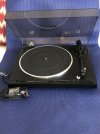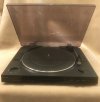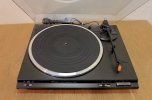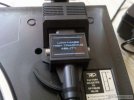You are using an out of date browser. It may not display this or other websites correctly.
You should upgrade or use an alternative browser.
You should upgrade or use an alternative browser.
Pioneer pl555z
- Thread starter Trayderji
- Start date
Record Player
Well-Known Member
Does this player have magnetic cartridge? Is is belt drive or direct drive and how is the performance? I am thinking to buy one...
This is a belt drive player with a p-mount style tonearm. I would recommend you take a pass on this one. Instead why don't you try an entry level turntable from Pro-Ject or Rega which are available new.
If you are thinking of Pioneer then you should check PLX 500 or even PLX1000 which is close to specs of Technics 1200.
Don’t go for used TTs unless you are technically knowledgeable about every aspect of a TT and have had a chance to play the used TT for sometime before purchase.
Don’t go for used TTs unless you are technically knowledgeable about every aspect of a TT and have had a chance to play the used TT for sometime before purchase.
reubensm
Well-Known Member
The Piioneer you've mentioned is what is called an entry level TT. If you invest in this, sooner or later you are going to start wanting to upgrade it. Hence it would be good to look for a better one which a marginal increase in budget. My father had is own turntable but when I wanted to have my own, I could not afford an expensive one so started with a Teac P988 and later upgraded to a Technics SLBD20B before jumping out of the 'plastic' world. Both the turntables from my initial times are similar to the Pioneer turntable which you mentioned so let me right up a few points for your reference and understanding.
All typical examples in this segment have a plastic base and dust cover, some basic plastic gears and plastic levers inside, a small DC motor with a pulley, a straight tonearm and a pluggable cartridge. Most turntables in this category are fully-automatic which means, place the record, push a button, the tonearm will descend, play and return. The platter is usually driven by a large belt which goes around an inside rim of the platter and the motor pulley. Usually these turntables play LPs and 45s, some having a electronic speed control which changes speeds while others just have a Pulley with 2 different channels, a lever just moves the belt between these channels. Some of these models (especially the ones manufactured after the 1980s, may have inbuilt phono stages with a switch to turn it on and off, depending on the model). As the motor is mostly a DC one, the turntable also has an inbuilt step down transformer for either 220v, 110v or 100v operation (or sometimes with multi-voltage switching) depending on the market for which the turntable was intended.
Here is a pic of the turntable which you've mentioned.

Here are pics of the Teac P988 and Technics SLBD20B turntables which I used, both being in the same segment:


So the golden question is - are these turntables junk - well not exactly but it depends on what you are looking for
Who normally invests in one like these - well that's a good question, The typical buyer is someone who does not have much money to spend and perhaps got a lot of records from somewhere, just wants to sample what's on them. Another category of buyer would be someone looking for a low cost used turntable, or someone shopping for a turntable purely by price and not by specs, or a all altogether beginner who want to sample the medium before diving into the deep end.
It is important to note that these are actually working tables which can produce very enjoyable music. These are not to be confused or compared with the el-cheapo Chinese Crosleys with ceramic carts and vintage/retro looking cabinets.
So what are the merits of turntables in this segment:
No knowledge of turntables needed to set it up, just place the platter over the deck, slip the belt over the motor pulley, place the platter mat on the platter, uncap the cartridge and you are ready to go. The cartridges used in this turntable are magnetic P-mount types (MM) and if you happen to have a good cart like the Audio Technica AT85EP mounted on the tonearm, you will get great quality if your turntable is wired to a good amp with an above average phonostage (like the NAD 3020, 304, etc). If the turntable model has its on inbuilt preamp, that gives you the flexibility of connecting the turntable to an amp which does not have an inbuild phonostage (like the NAD c320, c370, etc) and still listen to decent music. However if you amp has an inbuild phonostage, you'd have the option to switch off the internal one.
Another huge advantage is the auto functions. Just place the record on the platter, choose the record size (the tonearm needs to know where to land) and push the start button. The tonearm will take off from base, land, play and then return to base. Cant be simpler
Believe me, with a decent phonostage (like the DIY CNC phonopreamp) or with an amp with an inbuilt one (like the NAD 3020), these sound very good. I really enjoyed using them and had many hours of listening pleasure using them. Maintenance with record cleaning, stylus cleaning, turntable positioning, etc is pretty much as with other turntables. One major benefit is that the tonearm is 'factory calibrated' from a VTF and Antiskate perspective so one would not really have to fiddle around. The tracking weight is just under 3g usually which means, you can plug virtually any p-mount cart in and just play - yes its as simple as that and almost plug and play
Speed is pretty accurate, wow and flutter is pretty un-noticeable if your belt is a good one (either the original in good condition or have it replaced with a high quality one from turntableneedles.com if you get a used turntable.
The above sounds great, so why would one stay away?
Folks generally stay away from these turntables for the following reasons (not an exhaustive list but the common ones):
1) only p-mount carts can be used, one cannot use 1/2 inch mount ones
2) again with reference to point-1, the tonearm cannot be calibrated and as a result, cartridge options are less
3) a lot of the mech controlling the tonearm movement is made of plastic, needs to be properly lubricated and checked from time to time and these tend to break off over a period of time, causing functionality issues
4) The spindle assembly tends to wear off (its mostly made of plastic) over a period of time, causing the platter to wobble (this period of time will be several years so not really a concern)
5) Dampening of the plastic plinth is non-existent hence the turntable will work well with smaller powered amps. When used in hifi setups with loud speakers (especially woofers), the plinth tends to pick up feedback (but only at high levels - this can be controlled by isolation and proper positioning of the turntable)
6) the inbuild phonostage (if present) is essentially very basic, you may find it inadequate when listening through a hifi setup
7) the tonearm lift bench is often dampened by a spring. This needs to be lubricated regularly or the bench may not drop fully causing the tonearm to skate on the record. On the other hand, if the dampening disappears, the tonearm drop on the record would not be a very pleasant one putting stress on the stylus and cartridge cantilever, and also can cause damage to the records (however these turntables can be also operated in manual mode with auto return)
8) The tonearm wiring and interconnect quality is usually very basic (well, one cannot expect audiophile grade anyways )
)
9) The belts are generally low cost ones and tend to stretch/perish easily causing the belt to fall off every now and then, quite irritating actually. This can be sorted using a better quality belt but again, the turn table has to be in regular use for the belt to stay in shape
10) One has to be ultra-careful as the plinth and dust cover is very delicate and can easily crack or break
Here's a pic of the Pioneer's tonearm, says factory calibrated so essentially the user cannot change anything:

So now you can judge for yourself - a lot has to do with your intended use. If you just want to hear whats on those old records which you picked up or inherited, then these are fantastic. If you want to get into vinyl and become a long-term enthusiast, then the least you should look for is a turntable which has an adjustable tonearm, and headshell which can accommodate multiple cartridge types. Also a heavier plinth (either plastic or wood) should serve you better (the rest of the TT world is a deep ocean, for which more online research would be helpful )
)
Hope this helps!
All typical examples in this segment have a plastic base and dust cover, some basic plastic gears and plastic levers inside, a small DC motor with a pulley, a straight tonearm and a pluggable cartridge. Most turntables in this category are fully-automatic which means, place the record, push a button, the tonearm will descend, play and return. The platter is usually driven by a large belt which goes around an inside rim of the platter and the motor pulley. Usually these turntables play LPs and 45s, some having a electronic speed control which changes speeds while others just have a Pulley with 2 different channels, a lever just moves the belt between these channels. Some of these models (especially the ones manufactured after the 1980s, may have inbuilt phono stages with a switch to turn it on and off, depending on the model). As the motor is mostly a DC one, the turntable also has an inbuilt step down transformer for either 220v, 110v or 100v operation (or sometimes with multi-voltage switching) depending on the market for which the turntable was intended.
Here is a pic of the turntable which you've mentioned.

Here are pics of the Teac P988 and Technics SLBD20B turntables which I used, both being in the same segment:


So the golden question is - are these turntables junk - well not exactly but it depends on what you are looking for
Who normally invests in one like these - well that's a good question, The typical buyer is someone who does not have much money to spend and perhaps got a lot of records from somewhere, just wants to sample what's on them. Another category of buyer would be someone looking for a low cost used turntable, or someone shopping for a turntable purely by price and not by specs, or a all altogether beginner who want to sample the medium before diving into the deep end.
It is important to note that these are actually working tables which can produce very enjoyable music. These are not to be confused or compared with the el-cheapo Chinese Crosleys with ceramic carts and vintage/retro looking cabinets.
So what are the merits of turntables in this segment:
No knowledge of turntables needed to set it up, just place the platter over the deck, slip the belt over the motor pulley, place the platter mat on the platter, uncap the cartridge and you are ready to go. The cartridges used in this turntable are magnetic P-mount types (MM) and if you happen to have a good cart like the Audio Technica AT85EP mounted on the tonearm, you will get great quality if your turntable is wired to a good amp with an above average phonostage (like the NAD 3020, 304, etc). If the turntable model has its on inbuilt preamp, that gives you the flexibility of connecting the turntable to an amp which does not have an inbuild phonostage (like the NAD c320, c370, etc) and still listen to decent music. However if you amp has an inbuild phonostage, you'd have the option to switch off the internal one.
Another huge advantage is the auto functions. Just place the record on the platter, choose the record size (the tonearm needs to know where to land) and push the start button. The tonearm will take off from base, land, play and then return to base. Cant be simpler
Believe me, with a decent phonostage (like the DIY CNC phonopreamp) or with an amp with an inbuilt one (like the NAD 3020), these sound very good. I really enjoyed using them and had many hours of listening pleasure using them. Maintenance with record cleaning, stylus cleaning, turntable positioning, etc is pretty much as with other turntables. One major benefit is that the tonearm is 'factory calibrated' from a VTF and Antiskate perspective so one would not really have to fiddle around. The tracking weight is just under 3g usually which means, you can plug virtually any p-mount cart in and just play - yes its as simple as that and almost plug and play
Speed is pretty accurate, wow and flutter is pretty un-noticeable if your belt is a good one (either the original in good condition or have it replaced with a high quality one from turntableneedles.com if you get a used turntable.
The above sounds great, so why would one stay away?
Folks generally stay away from these turntables for the following reasons (not an exhaustive list but the common ones):
1) only p-mount carts can be used, one cannot use 1/2 inch mount ones
2) again with reference to point-1, the tonearm cannot be calibrated and as a result, cartridge options are less
3) a lot of the mech controlling the tonearm movement is made of plastic, needs to be properly lubricated and checked from time to time and these tend to break off over a period of time, causing functionality issues
4) The spindle assembly tends to wear off (its mostly made of plastic) over a period of time, causing the platter to wobble (this period of time will be several years so not really a concern)
5) Dampening of the plastic plinth is non-existent hence the turntable will work well with smaller powered amps. When used in hifi setups with loud speakers (especially woofers), the plinth tends to pick up feedback (but only at high levels - this can be controlled by isolation and proper positioning of the turntable)
6) the inbuild phonostage (if present) is essentially very basic, you may find it inadequate when listening through a hifi setup
7) the tonearm lift bench is often dampened by a spring. This needs to be lubricated regularly or the bench may not drop fully causing the tonearm to skate on the record. On the other hand, if the dampening disappears, the tonearm drop on the record would not be a very pleasant one putting stress on the stylus and cartridge cantilever, and also can cause damage to the records (however these turntables can be also operated in manual mode with auto return)
8) The tonearm wiring and interconnect quality is usually very basic (well, one cannot expect audiophile grade anyways
9) The belts are generally low cost ones and tend to stretch/perish easily causing the belt to fall off every now and then, quite irritating actually. This can be sorted using a better quality belt but again, the turn table has to be in regular use for the belt to stay in shape
10) One has to be ultra-careful as the plinth and dust cover is very delicate and can easily crack or break
Here's a pic of the Pioneer's tonearm, says factory calibrated so essentially the user cannot change anything:

So now you can judge for yourself - a lot has to do with your intended use. If you just want to hear whats on those old records which you picked up or inherited, then these are fantastic. If you want to get into vinyl and become a long-term enthusiast, then the least you should look for is a turntable which has an adjustable tonearm, and headshell which can accommodate multiple cartridge types. Also a heavier plinth (either plastic or wood) should serve you better (the rest of the TT world is a deep ocean, for which more online research would be helpful
Hope this helps!
Last edited:
Thankyou @reubensm again that was a great deal of information.....your guess was right I am not new but a novice, i had a hmv fiesta during my childhood and now i am again attracted towards vinyls due to its sound quality so at this point i dont want to spend to much.......but looking for some budget classic player .....i have decided not to go for pioneer.....
Join WhatsApp Channel to get HiFiMART.com Offers & Deals delivered to your smartphone!
Similar threads
- Replies
- 0
- Views
- 10K
- Replies
- 3
- Views
- 15K

